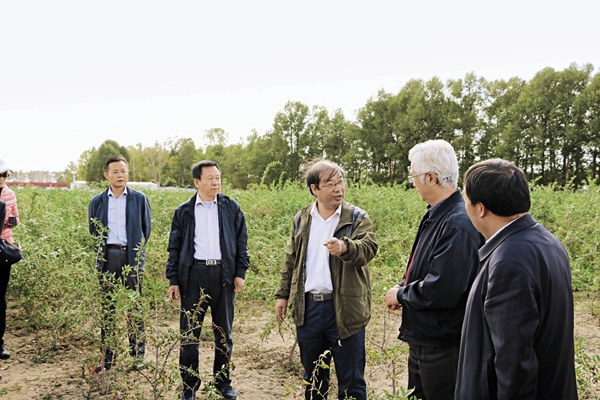Developing Eco-industry to Curb Desertification
China Today by Chen Xin, November 10, 2016 Adjust font size:

The head of a goji berry planting base introduces plant breeding to experts attending the desertification prevention and control seminar in September.
Developing ecological industries such as planting Chinese goji berry and medicinal herbs has brought about economic benefits for local farmers and herders, and prevented and controlled desertification. The goji berry forests serve as a natural shield for the ecological system, and work well for sand fixation.
The small goji fruit has turned the former desert into an oasis, enabling the villagers to live a better life. It has been proved to be an effective way to turn ecological management into a viable business and an extra source of income for the people.
Liu Shu is the former vice-chairman of the China Association for Science and Technology, a senior consultant for the UNEP desertification department, and a member of a senior expert panel on China’s anti-desertification project. Liu said that the sand industry, which was the core of the sixth industrial revolution put forward by respectable scientist Qian Xuesen, refers to creating an industrial cluster that integrates agriculture, industry, and trade, on the basis of a deep understanding of deserts and the Gobi in particular, as well as the application of modern technology and the concept of circular economy. The goji berry industry in Haixi, in fact, is the best example of the so-called sixth industrial revolution, which leads the country in managing and controlling desertification and developing green industry.
At the 2016 China Haixi Desertification Prevention and Control and Green Ecological Industrial Development Seminar local officials and technicians showcased new forestry technologies to plant trees and bushes to resist desertification and drought, and formed a prefecture-county-township three-tier technology extension system.
Haixi has fixed the sands in an area of more than 1.3 million mu by afforestation, closing hillsides for reforestation, and sand fixation projects. A total of 20 million mu of ecological forests is under key protection. The forest coverage rate now stands at 3.5 percent in the prefecture. At the same time, green fences have been added along the Qinghai-Tibet Railway and National Highway 315 in Delingha, the forefront city of the flowing sands. The fences have formed a green corridor that creates an unusual sight in the desert and protects transportation.